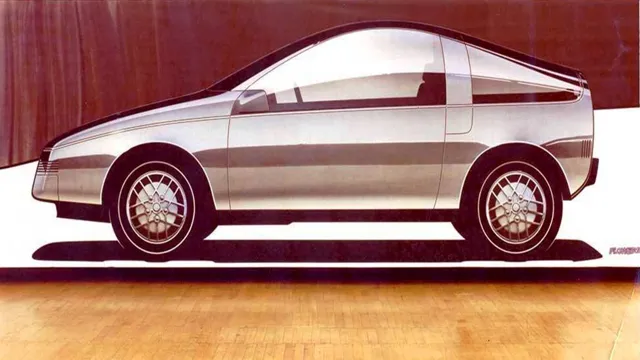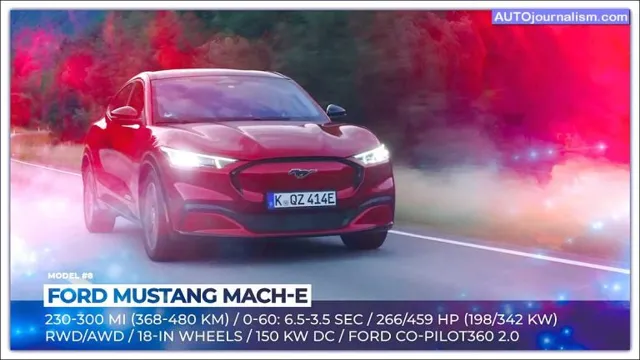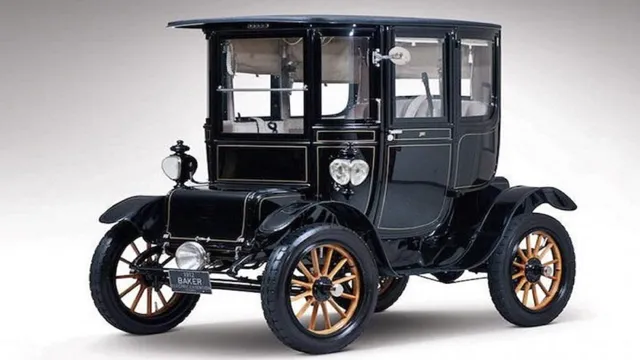Unraveling the Past: A Fascinating Journey through the History of GM Electric Cars
Imagine being able to drive an electric car that doesn’t need gasoline and that emits zero emissions into the environment. Sounds pretty cool, right? General Motors (GM) has been working on perfecting this technology for years, and the evolution of their electric cars has been nothing short of impressive. From the early days of the EV1 to the latest models, like the Bolt and the Volt, the improvements in technology have been staggering.
If you take a look back into the past, you’ll see that General Motors has always had a fascination with electric and hybrid vehicles. They were one of the first companies to produce an electric car back in the mid-90s. The famous EV1 was ahead of its time, and it was praised for its range, which was up to 140 miles on a single charge.
Sadly, it was discontinued due to a lack of demand, leaving electric car enthusiasts disappointed. Fast forward to 2010, when General Motors released the Chevy Volt, a plug-in hybrid electric vehicle. The Volt had a 40-mile range on purely electric mode, but it also had a backup gas engine that would kick in once the battery was depleted.
The release of the Volt was a huge step forward in electric car technology, proving that the public was ready for a more practical and efficient approach to electric cars. General Motors continued to make strides in electric car technology and design, eventually leading to the release of the Chevy Bolt, which was the first fully electric car that GM produced. The Bolt has a range of up to 259 miles on a single charge and has been praised for its superior technology and features.
Looking back on the evolution of GM electric cars, it’s clear that they have come a long way. From the early experimental days of the EV1 to the advanced technology of today’s Bolt, GM has proven that they are committed to producing high-quality, efficient electric vehicles. With more advancements on the horizon, we can’t wait to see what the future holds for electric cars.
Early Attempts
The history of GM electric cars dates back to the early 90s, when the automaker produced a small number of electric vehicles (EVs) called the EV Although innovative, these efforts were ultimately unsuccessful due to a lack of consumer demand and limited battery technology that prevented the cars from driving long distances. Despite pouring millions of dollars into their EV project, GM abruptly discontinued the program in 2002, vastly limiting the electric car market in the United States.
However, electric cars became more popular in the 2010s, and GM re-entered the market with the Chevy Volt and the all-electric Chevy Bolt. These vehicles have had much greater success due to increased battery technology and extensive public charging stations. Despite early failures, the history of GM electric cars showcases the constant push for innovation in the car industry.
GM’s Electrovair (1966)
GM’s Electrovair was an early attempt at creating an electric car that could compete with gas-powered vehicles, and it was unveiled in 196 While it wasn’t the first electric car, it was significant because it was created by a major automaker, General Motors. The Electrovair was based on a Chevrolet Corvair, and the engine was replaced with an electric motor that was powered by lead-acid batteries.
The car had a range of about 40 miles, which was considered impressive at the time. However, the batteries were heavy, and the car’s overall performance was lackluster. Despite this, the Electrovair represented an important step forward for electric vehicles, and it paved the way for future innovations in the industry.
Today, electric cars are more popular than ever, and companies are investing heavily in developing battery technology and charging infrastructure to support them.

Impact (1990-1991)
In 1990, Impact Wrestling was still in its nascent stages and was struggling to establish itself as a major player in the wrestling world. Early attempts were made to create a unique identity for the promotion, but they fell flat. Fans were just not responding to the bland and generic product that was being put out.
Impact needed to do something drastic to get people talking. That’s when they came up with the idea of having a tournament to crown their first-ever heavyweight champion. This was a bold move that paid off immensely.
The tournament was a huge success, with fans tuning in from all over the world to see who would come out on top. The company had finally found something that resonated with fans and gave them a reason to care about Impact Wrestling. This was just the beginning of the Impact revolution, which would ultimately lead to the company becoming one of the most innovative and exciting promotions in the world of wrestling.
The Rise of the Volt
The history of GM electric cars has seen many ups and downs over the years. However, there has been a recent rise in popularity for electric vehicles, particularly the Chevy Volt. The Volt has been praised for its sleek design and impressive electric range, making it a viable option for daily commutes and longer trips.
Its success can be attributed to various factors, including increased government incentives for electric vehicles and a shift towards more environmentally-friendly transportation options. The Volt’s rise also reflects a growing public interest in sustainable energy and reducing carbon emissions. While the history of GM electric cars has been a rocky one, the success of the Volt serves as a promising sign for the industry’s future.
Concept and Development
The Chevrolet Volt has been a game-changer in the world of green vehicles. This plug-in hybrid electric vehicle (PHEV) broke ground in late 2010 with its unique combination of an electric motor and a gasoline engine. This means that when the battery runs out, the gas engine kicks in to provide power, giving you a total range of up to 420 miles.
The Volt has gone through various iterations and upgrades, with a major overhaul in 201 The fuel economy has improved from 37 to 42 mpg, and the electric range has gone from 38 to 53 miles. This has made the Volt a favorite among eco-conscious drivers who want the best of both worlds.
In recent years, the Volt has faced competition from other PHEVs and electric vehicles, but it still holds its own in terms of versatility and overall value. With its unique ability to switch between electric and gasoline power, the Chevrolet Volt continues to be a high-ranking player in the green vehicle market.
Production and Release (2010)
The Chevy Volt rose to prominence in 2010, marking the beginning of a new era of sustainable, electric vehicles. The production and release of the Volt represented a turning point in the automotive industry, as it was one of the first mass-produced vehicles to run on battery-powered electricity. With its sleek design and impressive driving range of up to 40 miles on a single charge, the Volt quickly became a popular option among environmentally conscious consumers.
Its rise in popularity was also helped by generous government incentives and advancements in battery technology, which made electric vehicles more practical and affordable for everyday use. Overall, the Chevy Volt’s success marked a significant step forward in the development of electric vehicles, paving the way for a future where sustainable transportation is the norm.
Reception and Legacy
The reception and legacy of the Chevy Volt have undoubtedly been positive, especially considering the rise of electric cars in recent years. The Volt was one of the first plug-in hybrid electric vehicles to hit the market in 2010 and quickly gained recognition for its impressive electric range, which was unmatched by any other plug-in hybrid at the time. Although the Volt was initially met with some skepticism due to its higher price tag compared to traditional gas-powered vehicles, it ultimately paved the way for other automakers to explore the world of electrification.
As the cost of batteries continues to decline, and electric vehicle infrastructure continues to improve, the Volt’s legacy will only continue to grow as a significant player in the push towards a more sustainable transportation future. The rise of the Volt marks not only a turning point in the automotive industry but also a significant shift towards a greener, more sustainable future.
Current and Future Electric Cars from GM
The history of GM electric cars is a fascinating one that began in the mid-1990s with the launch of the EV Despite its success and popularity, GM decided to discontinue the production of the EV However, in recent years, the automaker has ramped up its efforts in the electric vehicle space with the launch of the Chevy Bolt, a fully electric car that boasts an impressive range of 238 miles on a single charge.
GM has also announced plans to introduce over 20 new electric vehicles by 2023, including the highly anticipated Cadillac Lyriq and the GMC Hummer EV. With these new introductions, GM is positioning itself as a leader in the electric vehicle market and is set to compete with the likes of Tesla and other major players in the space.
Bolt EV (2017-2020)
The Bolt EV was launched by GM in 2017, and has been praised for its impressive range and affordability compared to other electric cars on the market. With a range of over 200 miles on a single charge, the Bolt EV has proven to be a popular choice for eco-conscious drivers. However, GM is not stopping there.
The company plans to release multiple new electric vehicles in the coming years, with the goal of eliminating tailpipe emissions from all of its light-duty vehicles by 203 One of the most anticipated releases from GM is the Hummer EV, a fully electric pickup truck with up to 1,000 horsepower and the ability to travel up to 350 miles on a single charge. GM is also working on a new battery technology that aims to reduce costs and increase range, which could make electric cars even more accessible and practical for car buyers.
As the demand for electric cars continues to rise, it’s exciting to see what the future holds for GM and the industry as a whole.
Hummer EV (2021)
GM, electric cars, Hummer EV General Motors (GM) is leading the way in the transition to electric cars, with the recent launch of the highly anticipated Hummer EV. This fully electric pick-up truck represents a major milestone for the company, as it combines high performance with eco-friendliness. The Hummer EV has an impressive range of over 300 miles and can go from 0 to 60 mph in just 3 seconds.
Additionally, it features an advanced battery system that allows for fast charging and efficient power usage. But the Hummer EV is just the beginning for GM’s electric car lineup. The company plans to release a range of new electric vehicles, including the Cadillac Lyriq SUV and the Chevrolet Bolt EUV.
With an innovative approach and commitment to sustainable driving, GM is poised to be a major player in the electric car industry of the future.
Conclusion: GM’s Contribution to Electric Cars
As we wrap up the history of GM electric cars, it’s clear to see that the journey has been one of highs and lows. From the early experimental models of the 70s to the failed EV1 of the 90s, GM’s electric car journey has been a rollercoaster ride of innovation and setbacks. Yet, there’s no denying that GM’s continued pursuit of electric technology culminated in the success of the Chevy Bolt – an award-winning, all-electric vehicle that has revolutionized the market.
It’s a true testament to the power of resilience and perseverance – because despite the many obstacles along the way, GM has ultimately emerged as a trailblazing force in the electric car industry. Like the Bolt, GM’s future is bright, electric, and unstoppable. And with any luck, the history of GM electric cars will only continue to grow and evolve, paving the way for a cleaner, brighter, and more sustainable tomorrow.
“
FAQs
When did GM first introduce their electric car?
GM first introduced their electric car in 1996, with the release of the EV1.
Why did GM discontinue their electric car program?
GM discontinued their electric car program in 2003 due to low sales and high production costs.
Has GM released any new electric cars since discontinuing the EV1?
Yes, GM has released several new electric cars since discontinuing the EV1, including the Chevy Bolt and Cadillac Lyriq.
How does GM’s electric car technology compare to other automakers?
GM’s electric car technology is considered to be among the best in the industry, with high levels of range, efficiency, and performance.







